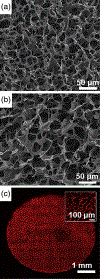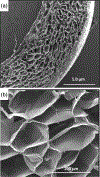Three-dimensional cryogels for biomedical applications
- PMID: 31408265
- PMCID: PMC7929089
- DOI: 10.1002/jbm.a.36777
Three-dimensional cryogels for biomedical applications
Abstract
Cryogels are a subset of hydrogels synthesized under sub-zero temperatures: initially solvents undergo active freezing, which causes crystal formation, which is then followed by active melting to create interconnected supermacropores. Cryogels possess several attributes suited for their use as bioscaffolds, including physical resilience, bio-adaptability, and a macroporous architecture. Furthermore, their structure facilitates cellular migration, tissue-ingrowth, and diffusion of solutes, including nano- and micro-particle trafficking, into its supermacropores. Currently, subsets of cryogels made from both natural biopolymers such as gelatin, collagen, laminin, chitosan, silk fibroin, and agarose and/or synthetic biopolymers such as hydroxyethyl methacrylate, poly-vinyl alcohol, and poly(ethylene glycol) have been employed as 3D bioscaffolds. These cryogels have been used for different applications such as cartilage, bone, muscle, nerve, cardiovascular, and lung regeneration. Cryogels have also been used in wound healing, stem cell therapy, and diabetes cellular therapy. In this review, we summarize the synthesis protocol and properties of cryogels, evaluation techniques as well as current in vitro and in vivo cryogel applications. A discussion of the potential benefit of cryogels for future research and their application are also presented.
Keywords: bioscaffolds; cellular therapies; cryogels; tissue engineering.
© 2019 Wiley Periodicals, Inc.
Figures





References
-
- Adrados BP, Galaev IY, Nilsson K, & Mattiasson B. (2001). Size exclusion behavior of hydroxypropylcellulose beads with temperature-dependent porosity. Journal of Chromatography. A, 930, 73–78. - PubMed
-
- Ak F, Oztoprak Z, Karakutuk I, & Okay O. (2013). Macroporous silk fibroin cryogels. Biomacromolecules, 14, 719–727. - PubMed
-
- Alves F, & Nischang I. (2013). Tailor-made hybrid organic-inorganic porous materials based on polyhedral oligomeric silsesquioxanes (POSS) by the step-growth mechanism of thiol-ene “click” chemistry. Chemistry: A European Journal, 19, 17310–17313. - PubMed
-
- Badeau BA, & DeForest CA (2019). Programming stimuli-responsive behavior into biomaterials. Annual Review of Biomedical Engineering, 21, 241–265. - PubMed
Publication types
MeSH terms
Substances
Grants and funding
LinkOut - more resources
Full Text Sources
Other Literature Sources

